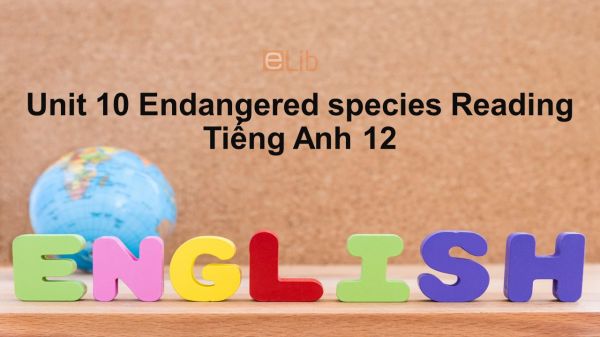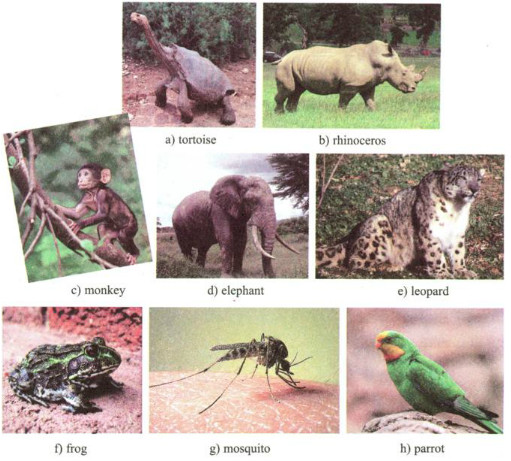Unit 10 lớp 12: Endangered species-Reading
Bài học Unit 10 Lớp 12 Endangered species phần Reading giúp các em có kĩ năng đoán từ mới qua ngữ cảnh và kĩ năng đọc lướt để nắm thông tin chính trong đoạn văn bài học. Qua đó các em có một cái nhìn tổng quát nhất về thế giới động vật trên thế giới, nhất là những con vật đang cần được bảo tồn.
Mục lục nội dung

Unit 10 lớp 12: Endangered species-Reading
1. Before You Read Unit 10 lớp 12
Work in pairs. Look at the pictures and answer the questions (Làm việc theo cặp. Nhìn vào các bức tranh và trả lời các câu hỏi)
a) Tortoise (rùa)
b) Rhinoceros (tê giác)
c) Monkey (con khỉ)
d) Elephants (con voi)
e) Leopard (con báo)
f) Frog (ếch nhái)
g) Mosquito (muỗi)
h) Parrot (con vẹt)
Guide to answer
1. Which of the animals and insects below can be found in Vietnam? (Loài động vật và côn trùng nào dưới đây có thể tìm thấy ở Việt Nam?)
⇒ All of these animals and insects except for leopards can be found in Vietnam. (Tất cả các loài động vật và côn trùng trừ báo có thể tìm thấy ở Việt Nam.)
2. Which of them is/are in danger of becoming extinct? (Loài nào trong số chúng đang có nguy cơ tuyệt chủng?)
⇒ I think rhinoceros is in danger of extinction. (Tôi nghĩ tê giác đang có nguy cơ tuyệt chủng.)
2. While You Read Unit 10 lớp 12
Read the text then do the tasks that follow (Đọc đoạn văn sau đó làm bài tập theo sau)
Các loài đang gặp nguy hiểm là các loài động thực vật đang có nguy cơ bị tuyệt chủng. Hơn 8 300 loài thực vật và 7 200 loài động vật trên trái đất có nguy cơ tuyệt chủng, và thêm hàng ngàn loài bị tuyệt chủng mỗi năm trước khi các nhà sinh vật học có thể nhận biết chúng.
Nguyên nhân chủ yếu gây tuyệt chủng các giống loài là do sự tàn phá môi trường sống, việc khai thác nhằm mục đích thương mại và sự ô nhiễm. Việc tháo nước khỏi các vùng đầm lầy, nạn phá rừng, sự đô thị hóa cùng việc xây dựng đường sá và đập nước đã hủy hoại hoặc làm tổn hại nghiêm trọng môi trường tự nhiên. Từ đầu thế kỷ 17, việc săn bắn động vật làm thực phẩm và các sản phẩm khác để phục vụ cho mục đích thương mại đã làm giảm đáng kể số lượng các loài quý hiếm trên thế giới. Hóa chất độc hại trong đất và không khí, nước ô nhiễm và nhiệt độ nước tăng cao đã đẩy nhiều loài đến bờ vực tuyệt chủng.
Sự tuyệt chủng của các loài động thực vật sẽ gây tổn hại đến hệ sinh thái. Đối với chúng ta, việc giữ gìn hệ sinh thái quan trọng về nhiều mặt. Thí dụ, nhờ sự đa các chủng loài mà con người có thực phẩm, không khí và nước sạch, đất màu mỡ để trồng trọt. Ngoài ra, chúng ta còn hưởng thụ được nhiều lợi ích từ nhiều loại thuốc và sản phẩm khác mà hệ sinh thái mang lại.
Người ta đã có nhiều nỗ lực bảo tồn nhằm bảo vệ những giống loài có nguy cơ tuyệt chủng. Sách Đỏ - danh sách thế giới về các loài động vật có nguy cơ tuyệt chủng và dễ bị nguy hại - đã được giới thiệu nhằm nâng cao nhận thức của con người về sự cần thiết bảo tồn môi trường thiên nhiên. Chính phủ các nước đã ban hành các đạo luật ngăn cấm việc buôn bán và săn bắt bừa bãi động vật hoang dã nhằm bảo vệ các loài này. Nhiều khu bảo tồn động thực vật hoang dã đã được thành lập để nhiều loài có nguy cơ tuyệt chủng có cơ may sống sót và phát triển.
2.1. Task 1 Unit 10 lớp 12
The nouns in column A all appear in the passage. Match each of them with a suitable definition in column B (Các danh từ ở cột A đều có mặt trong đoạn văn. Ghép mỗi từ với định nghĩa thích hợp ở cột B)
Guide to answer
1. c
Extinction (tuyệt chủng): a situation in which a plant, an animal, a way of life, etc. stops existing
2. d
Habitat (môi trường sống): the natural environment in which a plant or animal lives
3. a
Biodiversity (đa dạng sinh học): the existence of a large number of different kinds of animals and plants which make a balanced environment
4. b
Conservation (sự bảo tồn): the act of preventing something from being lost, wasted, damaged or destroyed
2.2. Task 2 Unit 10 lớp 12
Choose A, B, C or D to complete the following sentences about the reading passage (Chọn A, B, C hoặc D để hoàn thành các câu sau về bài đọc)
Guide to answer
1. D
The number of species around the globe threatened with extinction is over 15000. (Số lượng loài trên thế giới bị đe dọa tuyệt chủng là hơn 15000 loài.)
2. B
Which of the following is NOT mentioned as a primary cause of species extinction? – natural selection (Cái nào dưới đây không được đề cập như là nguyên nhân hàng đầu sự của tuyệt chủng các loài? – Sự chọn lọc tự nhiên.)
3. A
The Red List is a special book that provides names of vulnerable and endangered animals. (Sách đỏ là quyển sách đặc biệt cung cấp tên của những loài đang vật có nguy cơ tuyệt chủng và dễ bị nguy hại.)
4. A
The development of wildlife habitat reserves helps save a large number of endangered species. (Sự phát triển của việc bảo tồn môi trường sống hoang dã đã giúp cứu số lượng lớn các loài có nguy cơ tuyệt chủng.)
5. B
The best title for the passage is endangered species and their benefits. (Tiêu đề phù hợp nhất cho bài văn là Các loài có nguy cơ tuyệt chủng và những lợi ích của chúng.)
2.3. Task 3 Unit 10 lớp 12
Find evidence in the passage to support these statements (Tìm những chứng cứ ở đoạn văn để hỗ trợ những phát biểu này)
Guide to answer
1. Pollution is one of the main causes of species extinction. (Ô nhiễm là một trong những nguyên nhân chính của sự tuyệt chủng các loài.)
⇒ Câu 1 đoạn 2
2. Species diversity has provided humans with so many essential things. (Sự đa dạng về loài mang lại cho con người rất nhiều lợi ích.)
⇒ Đoạn 3
3. There are a number of ways to help save endangered species. (Có nhiều cách để bảo tồn các loài có nguy cơ tuyệt chủng.)
⇒ Đoạn 4
3. After You Read Unit 10 lớp 12
Work in pairs. Summarize the reading passage by writing ONE sentence for each paragraph (Làm việc theo cặp. Tóm tắt đoạn văn bằng cách viết MỘT câu cho từng đoạn văn)
Guide to answer
Paragragh 1: Over fifteen thousand plant and animal species around the globe are threatened with extinction. (Hơn 15 nghìn loài động thực vật quanh Trái Đất bị đe dọa với nguy cơ bị tuyệt chủng.)
Paragraph 2: The main causes of species extinction are habitat destruction, commercial exploitation and pollution. (Nguyên nhân chính của sự tuyệt chủng các loài là sự phá hủy môi trường sống, sự khai thác thương mại và ô nhiễm.)
Paragraph 3: Biodiversity is important for humans since it provides food, clean water, air, fertile soil, many medicines and other products. (Đa dạng sinh thái quan trọng đối với con người vì nó cung cấp thức ăn, nước sạch, không khí, đất, thuốc và nhiều sản phẩm khác.)
Paragraph 4: Different efforts have been made to save and conserve endangered species. (Nhiều nỗ lực khác nhau đã được thực hiện để cứu lấy và bảo tồn các loài có nguy cơ tuyệt chủng.)
4. Practice Task 1
Read the passage carefully and choose the correct answer (Đọc đoạn văn và chọn câu trả lời đúng)
Species that belong to an area are said to be native species. Typically, they have been part of a given biological landscape for a long period, and they are well adapted to the local environment and to the presence of other native species in the same general habitat. Exotic species are interlopers, foreign elements introduced intentionally or accidentally into new settings through human activities. In one context an introduced species may cause no obvious problems and may, over time, be regarded as being just as "natural" as any native species in the same habitat. In another context, exotics may seriously disrupt delicate ecological balances and create a cascade of unintended consequences. The worst of these unintended consequences arise when introduced species put native species in destruction by preying on them, altering their habitats, or out-competing them in the struggle for food resources. Although biological introductions have affected environments the world over, the most destructive, effects have occurred on islands, where introduced insects, cats, pigs, rats, mongooses, and other nonnative species have caused the grave endangerment or outright extinction of literally hundreds of species during the past 500 years.
One of other reason to cause species extinction is overexploitation. This word refers to the utilization of a species at a rate that is likely to cause its extreme endangerment or outright extinction. Among many examples of severe overexploitation, the case of the great whales stands out in special relief. By the middle of the 20th century, unrestricted whaling had brought many species of whales to incredibly low population sizes. In response to public pressure, in 1982 a number of nations, including the USA, agreed to an international moratorium on whaling. As a direct result, some whale species which are thought to have been on extinction's doorstep 25 years ago have made amazing comebacks, such as grey whales in the western Pacific. Others remain at great risk. Many other species, however, continue to suffer high rates of exploitation because of the trade in animal parts. Currently, the demand for animal parts is centered in several parts of Asia where there. is a strong market for traditional medicines made from items like tiger bone and rhino horn.
1. Native species _______.
a. are not used to the local environment
b. never get along well with other native species in the same environment
c. tend to do harm to exotic species
d. have been part of a given biological landscape for a long period
2. Exotic species _______.
a. do no harm to native species and the local environment
b. may kill native species for food
c. always share the environment peacefully with native species
d. help to make the local environment more ideal to survive
3. According to the first paragraph, _______.
a. non-native species have caused badly damage to native ones
b. introducing new exotic species to local environments is necessary
c. exotic species have never been introduced on islands
d. very few native species have been damaged by exotic species
4. According to the second paragraph, by the middle of the 20 century ___.
a. whale population was the most crowded in marine life
b. whale hunting was illegal
c. whale population increased dramatically
d. whaling was not restricted
5. Tiger bone and rhino horn _______.
a. are not popular in Asian markets
b. are never in the trade of animal parts
c. are used for making traditional medicines
d. cannot be found in Asian markets
5. Practice Task 2
Fill in each numbered blank with one suitable word or phrase (Điền vào mỗi chỗ trống được đánh số sau đây với từ hay cụm từ phù hợp)
The World Wide Fund for Nature (WWF) is an international (1) _____- governmental organization for the (2) _____, research, and restoration of the environment. The organization was (3) _____ as a charitable trust on September 11, 1961, in Morges, Switzerland, under the name World Wildlife Fund. It was an initiative of Julian Huxley and Max Nicholson.
It is the world's largest independent conservation organization with over 5 million (4) _____ worldwide, working in more (5) _____ 90 countries, supporting 100 conservation and environmental projects around the world. It is a charity, with (6) ____ 9% of its funding coming from voluntary. (7) ___ by private individuals and businesses.
The group says its mission is "to halt and reverse the (8) _____ of our environment". Currently, much of its work focuses on the conservation of three biomes that contain most of the world's biodiversity: forests, freshwater ecosystems, and oceans and coasts. Among other issues, it is also concerned (9) _____ endangered species, pollution, and climate change. The organization (10) ____ more than 20 field projects worldwide. In the last few years, the organization set up offices and operations around the world.
1. a. non b. not c. no d. nor
2. a. challenge b. keeping c. conservation d. awareness
3. a. produced b. discovered c. used d. formed
4. a. supporters b. residents c. inhabitants d. citizens
5. a. as b. than c. to d. as to
6. a. generally b. individually c. commercially d. approximately
7. a. deposits b. donations c. refunds d. loans
8. a. destroy b. destructive c. destruction d. destroyed
9. a. on b. by c. with d. upon
10. a. goes b. walks c. reaches d. runs
6. Conclusion
Qua bài học này các em cần lưu ý một số từ vựng sau
- be driven to the verge of… : bị đầy đến bờ của…..
- biologist [bai'ɔlədʒist] (n): nhà sinh vật học
- deforestation [di,fɔris'tei∫n] (n):sự phá rừng
- derive (from) [di'raiv] (v): bắt nguồn từ
- enact (v): ban hành (đạo luật)
- leopard ['lepəd] (n): con báo
- parrot (n): con vẹt
- reserve [ri'zə:v] (n): khu bảo tồn,(v): dự trữ
- urbanization [,ə:bənai'zei∫n] (n): sự đô thị hoá
- vulnerable ['vʌlnərəbl] (a): dễ bị tổn thương
- wildlife ['waildlaif] (n): động vật hoang dã
- endanger [in'deindʒə(r)] (v): gây nguy hiểm
- danger ['deindʒə] (n):mối đe doạ,sự nguy hiểm
- extinction [iks'tiçk∫n] (n): duyệt chủng
- globe [gloub] (n): quả cầu
- global ['gloubəl] (adj): toàn cầu
- damage (v): gây tổn hại, (n): sự thiệt hại
- contaminate (v): làm bẩn, làm nhiễm (bệnh)
- fertile ['fə:tail] (adj): màu mỡ
- awareness (a): nhận thức về ai/cái gì
- conservation [,kɔnsə:'vei∫n] (n): sự bảo tồn
- survive [sə'vaiv] (v): sống sót; còn lại
- essential (adj): cần thiết, chủ yếu, (n): yếu tố cần thiết
- context ['kɔntekst] (n): bối cảnh, ngữ cảnh
- occur [ə'kɜ:(r)](v): t́ìm thấy, xuất hiện
- utilization [,ju:təlai'zei∫n] (n): sự tận dụng
Tham khảo thêm
- doc Unit 10 lớp 12: Endangered species-Speaking
- doc Unit 10 lớp 12: Endangered species-Listening
- doc Unit 10 lớp 12: Endangered species-Writing
- doc Unit 10 lớp 12: Endangered species-Language Focus






